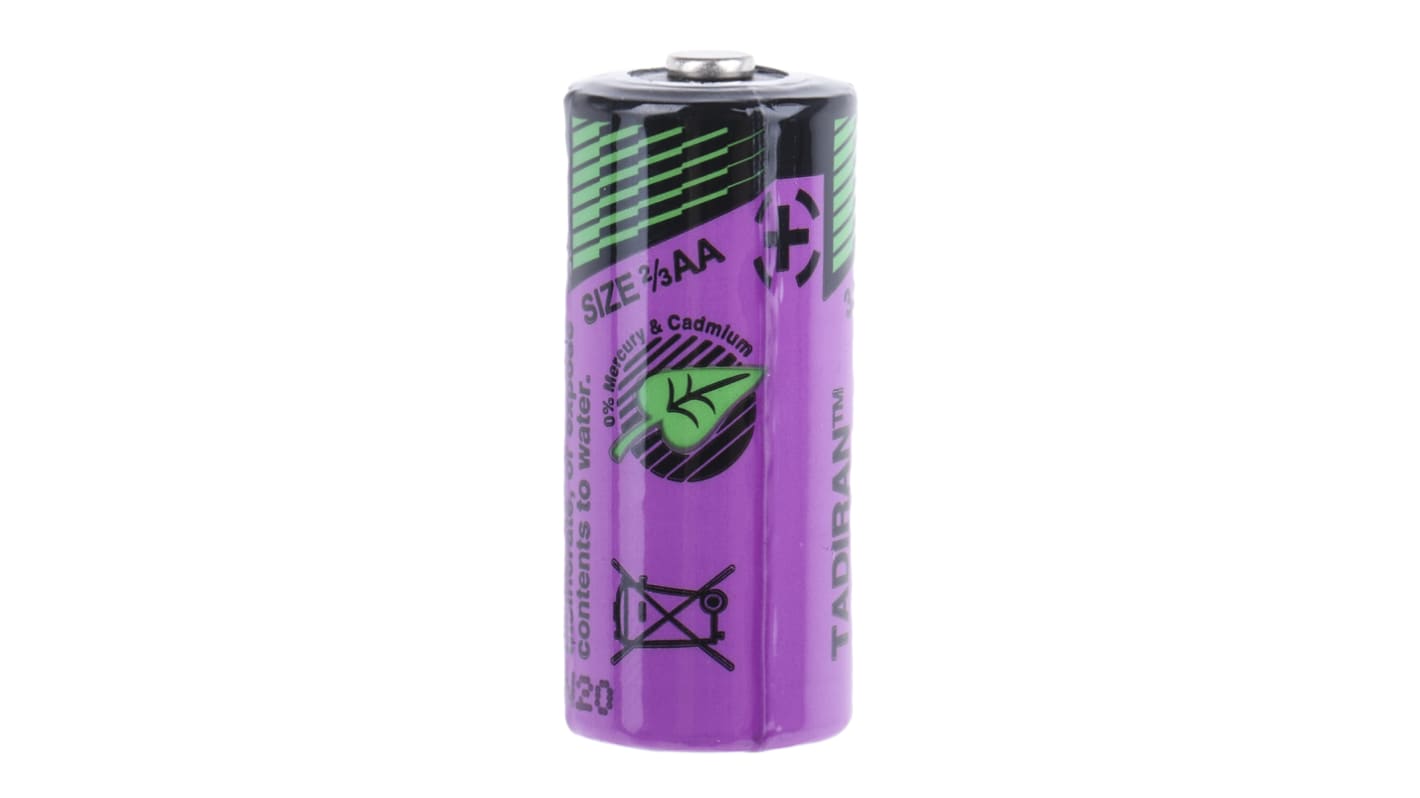Tadiran Lithium Thionyl Chloride 3.6V, 2/3 AA 2/3 AA Battery
- RS Stock No.:
- 920-9764
- Mfr. Part No.:
- SL-561S
- Brand:
- Tadiran

Subtotal (1 unit)*
£14.21
(exc. VAT)
£17.05
(inc. VAT)
FREE delivery for orders over £50.00
In Stock
- 271 unit(s) ready to ship
- Plus 15 unit(s) ready to ship from another location
- Plus 300 unit(s) shipping from 02 March 2026
Need more? Click ‘Check delivery dates’ to find extra stock and lead times.
Units | Per unit |
|---|---|
| 1 + | £14.21 |
*price indicative
- RS Stock No.:
- 920-9764
- Mfr. Part No.:
- SL-561S
- Brand:
- Tadiran
Specifications
Technical Reference
Legislation and Compliance
Product Details
Find similar products by selecting one or more attributes.
Select all | Attribute | Value |
|---|---|---|
| Brand | Tadiran | |
| Size | 2/3 AA | |
| Nominal Voltage | 3.6V | |
| Chemistry | Lithium Thionyl Chloride | |
| Capacity | 1.1Ah | |
| Terminal Type | Standard | |
| Dimensions | 14.7 (Dia.) x 33.5mm | |
| Select all | ||
|---|---|---|
Brand Tadiran | ||
Size 2/3 AA | ||
Nominal Voltage 3.6V | ||
Chemistry Lithium Thionyl Chloride | ||
Capacity 1.1Ah | ||
Terminal Type Standard | ||
Dimensions 14.7 (Dia.) x 33.5mm | ||
RoHS Status: Exempt
- COO (Country of Origin):
- DE
Tadiran 3.6 V Lithium Thionyl Chloride Batteries
Lithium 3.6 V tagged batteries from Tadiran, designed for use in high-temperature applications where a device is used for a long period of time such as Industrial control equipment, sub-sea transponders and temperature monitoring device. These batteries are free from heavy materials, offers a unique construction making them safe and environmentally friendly.
Lithium batteries what are the advantages?
• Nominal voltage of 3.6 V, greater than conventional cells
• High-temperature range −55゚C to +85゚C
• Very high-temperature range −55゚C to +130゚C (RS Stock no: 920-9764)
• High energy density, the highest of any primary battery
• High-temperature range −55゚C to +85゚C
• Very high-temperature range −55゚C to +130゚C (RS Stock no: 920-9764)
• High energy density, the highest of any primary battery
Features and Benefits
• Lithium Thionyl Chloride
• AA, 1/ 2 AA, 2/3 AA batteries
• Excellent memory back-up characteristics
• Extended temperature range
• Hermetically sealed casing
• Optimized voltage level after storage, reducing passivation problems
• Best if stored no more than 3 years
• AA, 1/ 2 AA, 2/3 AA batteries
• Excellent memory back-up characteristics
• Extended temperature range
• Hermetically sealed casing
• Optimized voltage level after storage, reducing passivation problems
• Best if stored no more than 3 years
Typical Applications
Lithium batteries are used in electronic devices that require a small, compact source of power. Example applications include:
• Utility Meters
• Onboard computers
• Alarm systems
FAQ’s
Are Lithium Batteries Harmful?
Lithium batteries can sometimes leak a substance called potassium hydroxide which is a caustic agent that can cause eye, skin and respiratory irritations. This risk is reduced by not mixing different manufacturer battery types, batteries of different chemistries and by the replacement of all batteries at the same time.
How to dispose of Alkaline/Lithium Batteries?
Recycle responsibly, a wide range of schemes are available.
Safety Advice
Keep out of sight and reach of children
Guidance:
• Always install the batteries correctly as per instruction
• Ensure that the contact points are clean and conductive
• Do not mix different types of battery
• Do not heat or attempt to recharge the battery
• Do not dispose of in a fire
Lithium batteries are used in electronic devices that require a small, compact source of power. Example applications include:
• Utility Meters
• Onboard computers
• Alarm systems
FAQ’s
Are Lithium Batteries Harmful?
Lithium batteries can sometimes leak a substance called potassium hydroxide which is a caustic agent that can cause eye, skin and respiratory irritations. This risk is reduced by not mixing different manufacturer battery types, batteries of different chemistries and by the replacement of all batteries at the same time.
How to dispose of Alkaline/Lithium Batteries?
Recycle responsibly, a wide range of schemes are available.
Safety Advice
Keep out of sight and reach of children
Guidance:
• Always install the batteries correctly as per instruction
• Ensure that the contact points are clean and conductive
• Do not mix different types of battery
• Do not heat or attempt to recharge the battery
• Do not dispose of in a fire
Approvals
Compliant with IEC 60086-4 safety standard
Related links
- Tadiran Lithium Thionyl Chloride 3.6V, 2/3 AA 2/3 AA Battery
- Tadiran Lithium Thionyl Chloride 3.6V, 2/3 AA Battery
- RS PRO Lithium Thionyl Chloride 3.6V, 2/3 AA 2/3 AA Battery
- Tadiran Lithium Thionyl Chloride 3.6V, 1/2 AA Battery
- Tadiran Lithium Thionyl Chloride 3.6V, DD Battery
- Tadiran Lithium Thionyl Chloride AA Battery 3.6V
- Tadiran Lithium Thionyl Chloride 3.6V, AA Lithium Speciality Size Battery
- Tadiran Lithium Thionyl Chloride 3.6V, D Lithium Speciality Size Battery
